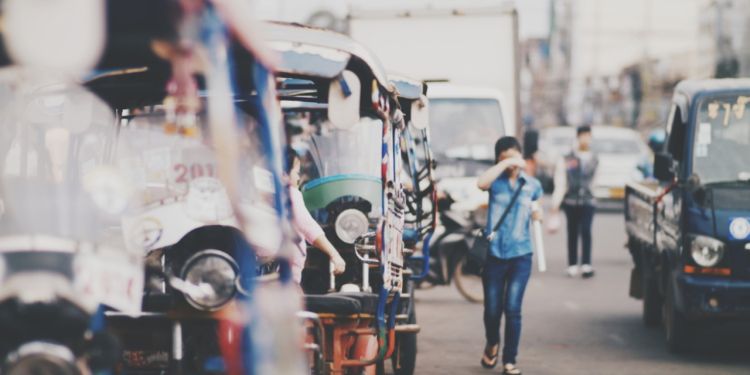Transports in the Philippines

Transportation and getting around are part of everyday life. So if you intend to settle in the Philippines, you should know that the country has a developed transports network, including buses, subways, taxis, as well as traditional means of transport such as Jeepneys, pedicabs, kulong kulongs (like a sidecar) and tricycles, etc. You can choose from these, depending on the length and purpose of your trip and your budget as well.
Jeepneys in the Philippines
Jeepneys are a true legacy of the Second World War, almost considered a symbol of the Philippines. Indeed, many years ago, Filipinos used to recycle old jeeps left by the US military to make public transport. Nowadays, Jeepneys are manufactured in factories and are decorated in such a way that they do not fail to attract tourists. Note that Jeepneys operate on official routes at regulated prices.
Jeepneys operate on fixed routes and can be flagged down along the street or at designated stops/stations. Please do remember that you may need to say “para” or “para po” for them to know that you would like to get off the jeep. Passengers pay the fare upon boarding, and there is no set schedule, meaning they will leave when the seats are full. Jeepneys are inexpensive, fun, and a novel way of getting around the Philippines.
On a negative note, although Jeepneys are an excellent mode of transportation for regular commuters in the Philippines, there have been challenges in recent years. The jeepney fleet is quite old; the vast majority of Jeepneys currently in operation are poorly maintained and don't meet modern vehicle air quality standards, maintenance issues, and pollution that impact air quality affecting both drivers and commuters.
Buses in the Philippines
The Philippines also has several private bus companies that operate in its major cities and provinces. Most of these buses are air-conditioned, but you will still find some that are not. Buses covering long distances normally have a stopover in the middle of the trip for toilet breaks unless you are in a deluxe bus that has a toilet inside, although the latter type of bus is limited.
These buses are operated by GV Florida Bus Company, more commonly known as ‘Florida' and also Victory Liner.
Inner-city bus tickets can be purchased at the bus stations- one way only. An ordinary bus ticket is p10 for the first 5 km, increasing incrementally by p1.75 per additional kilometre beyond that.
Minibuses in the Philippines
Minibuses in the Philippines are particularly appropriate for short trips. You can find them in provinces where public transport is rare. But beware! These carry not only human beings but livestock and goods as well. Minibuses are generally less comfortable than buses.
Tricycles in the Philipppines
As regards the traditional means of transport, just like an Indian rickshaw and the Thai tuk-tuk, the tricycle is a motorized three-wheeler to which a cabin is attached and forms an essential part of the local landscape. These are only ideal for short trips. The tricycle can generally transport 2 to 7 people at a time, but the size depends on the city since some cities have tricycles that are bigger and even have seats at the back. Another variation is the Motorela in Northern Mindanao, which has four wheels.
A tricycle exclusively for one expat for a small journey is around p150/USD 2.60, or sharing a tricycle will cost around p50 / 84 cents.
Pedicabs in the Philippines
Pedicabs are quite similar to three-wheelers, except that these are pulled by a bicycle and, therefore, not motorized. The cabin is either found on the side or the front. Just like the tricycle, these are also only ideal for short trips.
Railways in the Philippines
There are two railway networks in the Philippines operated by the government, together with the Metro Rail Transit (MRT) Corporation and the Light Rail Transit (LRT) Authority, which covers only Metro Manila. There is also the Philippine National Railways (PNR), which only operates within Luzon. Currently, there are no other functional railways outside Luzon. These are quite rapid, rates are affordable, and the networks are all above ground.
The best and easiest way to pay is through the beep card, which costs 200 pesos and has a balance of 70 pesos. You can reload it by going to beep card booths or MRT booths with any amount you wish, depending on your frequency and distance of journeys. Alternatively, you can buy a one-way ticket commonly used by most commuters in Manila, starting from p30 upwards.
Taxis in the Philippines
Taxi services in the Philippines are available in bigger towns or cities, but it can be a mixed bag regarding reviews and feedback. While there are many reputable taxi companies, there are also reports of overcharging, detours, reckless driving, and fraudulent schemes. Make sure the driver turns on the meter before taking off on the trip.
Grab, however, is the most common and recommended taxi provider in bigger cities and towns, and it works by booking on the app.
Important:
Ensure the driver turns on the meter at the start of the journey.
Aside from the P45 booking fee, Grab imposes P2 per minute plus P15 per kilometre, then doubles this during traffic.
Ridesharing in the Philippines
Being the preferred transport by millennials and professionals within central business districts, ridesharing has exploded with the company Grab (who took over Uber's operation in Southeast Asia), currently dominating the market in the country. New entrants are expected to come in, such as Joyride, Go Lag, and Owto. Just make sure you download their apps beforehand.
Aeroplanes in the Philippines
You can, of course, travel from one island to another by plane if you're willing to spend a bit more. Prices can be up to three times that of a boat trip. However, you can choose your flights from different companies, including Philippine Airlines, Cebu Pacific Air, and Air Asia.
Boats and ferries in the Philippines
With more than 7,000 islands, the Philippines had to set up an effective commercial maritime transport network. Travel fares are rather affordable. If you choose ferries, you can even take your personal belongings and car with you. Most ferries have no official website but rather market themselves through Facebook. (Facebook is the biggest social network by far in the Philippines.) A standard ferry journey should only cost approx. p1000/USD 18.
Useful links:









